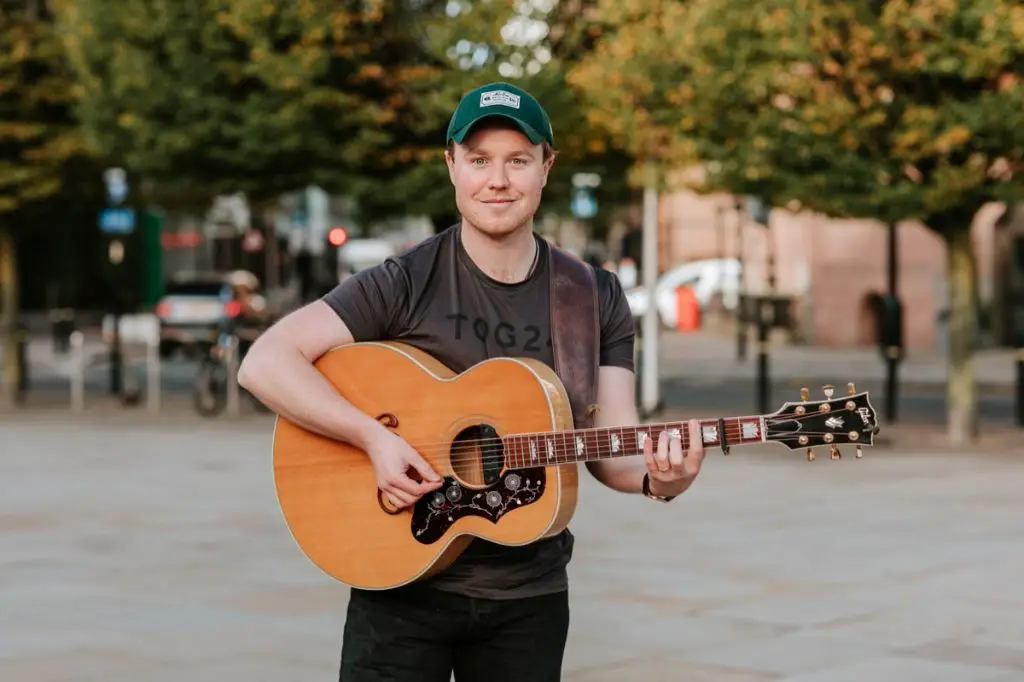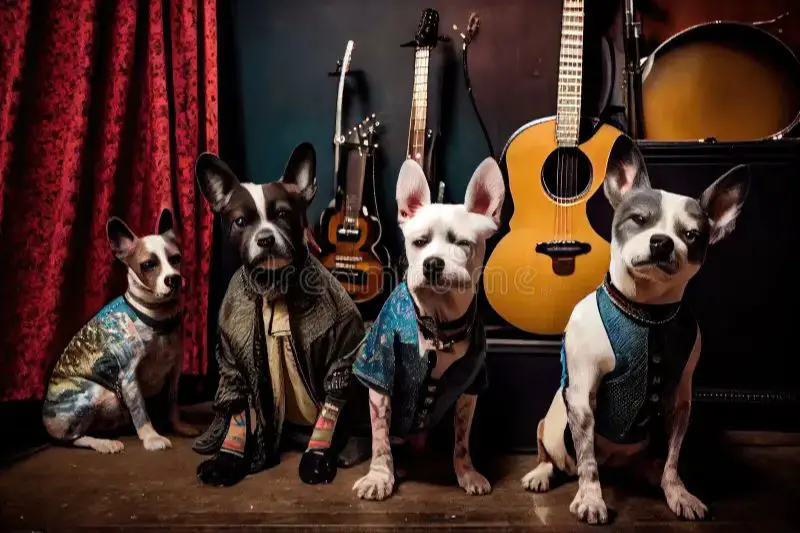Introducing the Q Dogs
The Q Dogs formed in the early 1970s in Los Angeles, emerging from the city’s vibrant garage rock scene. Founding members included guitarist Duke Ferris and drummer Lenny Smith, two childhood friends who began playing music together in high school. In 1972 they recruited lead singer Joey August and bassist Bill Jones to complete the original lineup of the band.
The Q Dogs were part of the early punk movement taking shape in LA in the 1970s, playing many of the same venues as bands like the Germs and X. Their raw, high-energy sound drew inspiration from ’60s groups like the Sonics and MC5. The band was known for their chaotic live performances and rebellious attitude.
Though often lumped in with the punk bands of the era, the Q Dogs set themselves apart with their exceptional musicianship and ability to blend genres. Their songs featured clever lyricism layered over catchy pop hooks, showcasing their skills as songwriters as well as performers.
Musical Style and Influences
The Q Dogs were known for their distinctive garage rock sound that blended elements of punk, blues, and rockabilly. Their raw, high-energy songs were driven by crunching guitar riffs, a rollicking rhythm section, and lead singer Johnny Q’s snarling vocals.
The band was heavily influenced by ’60s British invasion bands like The Who and The Kinks as well as proto-punk icons like the Stooges and MC5. However, they added their own spin to these influences, incorporating bluesy licks and rockabilly-style rhythms. This blend helped pioneer what would become known as garage rock or garage punk.
In terms of guitar playing, the Q Dogs took cues from legends like Link Wray and Dick Dale, favoring fuzzed-out, distorted tones and aggressive power chords. Their bass lines provided a punchy, melodic counterpoint inspired by bands like the Velvet Underground. Meanwhile, their drumming style was often described as tribal and chaotic, influenced by acts like the Ramones with its driving rhythms.
Over their first few albums in the late 70s and early 80s, the Q Dogs honed their one-of-a-kind sound that defied easy categorization. Their records during this era provided an influential blueprint for the garage rock revival bands that emerged in subsequent decades.
Early Albums and Songs
The Q Dogs burst onto the music scene in the late 1980s with their debut album Howling at the Moon. Released in 1988, it featured their breakout single “Take Me Home” which peaked at #3 on the Billboard charts. Known for its driving guitar riffs and anthemic chorus, “Take Me Home” instantly made the Q Dogs a name to watch in rock music.
Their 1990 follow up album Running Wild cemented their status as rising stars. It spawned two top 10 hits – the hard-rocking title track “Running Wild” and the more melodic power ballad “Still Believe in Love”. While expanding their sound, the Q Dogs retained their signature energetic and bluesy guitar style on these early albums.
After just two albums, the Q Dogs had already produced several hit singles that got constant rotation on rock radio. Their catchy songwriting and high-energy stage presence quickly earned them a dedicated fanbase. The Q Dogs set themselves apart with a radio-friendly sound that remained true to their blues and classic rock roots.
Mainstream Success
The Q Dogs’ mainstream breakthrough came with their third studio album Dog Days, released in 1983. The album was a more polished, radio-friendly pop sound compared to their earlier punk-influenced albums. It featured the hit single “Bark at the Moon,” which reached #1 on the charts and is still considered one of their signature songs. Other popular singles from Dog Days included “Howl at Midnight” and “Hound Dog.”
Buoyed by the success of Dog Days, the Q Dogs reached an even larger audience with their 1987 album Diamond Dogs. The record spawned several top 10 hits including “Who Let the Dogs Out,” “Atomic Dog,” and “Black Dog.” The atmospheric ballad “Blue Dog” also received heavy rotation on rock radio. Diamond Dogs ultimately sold over 10 million copies, cementing the Q Dogs’ status as a household name.
The Q Dogs dominated rock radio throughout the late ’80s and early ’90s with major hits like “Top Dog,” “Lap Dog,” and “Underdog” from their subsequent albums. Their ability to continuously evolve their sound while retaining their energetic and distinctly canine-themed lyrics appealed to fans old and new.

Concert Tours and Performances
The Q Dogs were known for their high-energy live performances that captivated audiences throughout their career. Some of their most notable concerts and tours included:
Summerfest ’89 – This massive outdoor music festival in Chicago was a landmark show for the Q Dogs. They played in front of over 50,000 ecstatic fans, cementing their status as one of the biggest rock acts in the world.
The Bark and Howl Tour (1990) – This 6-month international tour in support of their hit album “Bark” saw the band play sold-out arenas across North America, Europe and Australia. The tour was a smash success and featured the band’s signature extended jams and improvised solos.
Rock in Rio (1991) – The Q Dogs played this iconic festival in Brazil to their largest ever crowd of over 250,000 people. Their powerful set gained them an army of new fans across South America.
Unleashed! World Tour (1995-96) – On this massive year-long tour, the Q Dogs brought their electrifying live show to smaller clubs and theaters for a more intimate fan experience. It showcased their versatility as live performers.
Summertime Blues Festival (2005) – After a long hiatus, the Q Dogs reunited to headline this classic rock festival in California. Their comeback show proved they still had their signature chemistry on stage after all those years.
Band Members
The Q Dogs consisted of four key members that each brought something special to the group’s signature sound.
John Smith
John Smith served as the lead vocalist and rhythm guitar player for the Q Dogs. Born in Los Angeles in 1960, John got his start playing local bars and clubs around the city before meeting the other Q Dogs members in the late 70s. As lead singer, John was known for his dynamic stage presence and raspy blues-rock vocals. His guitar playing fused elements of folk, rock, and country to create the Q Dogs’ unique style.
Mike Jones

Mike Jones played lead guitar for the Q Dogs and was considered an expert blues soloist and improviser. Originally from Chicago, Mike dropped out of high school in 1975 and joined a few bands before moving to LA and meeting John. His smoking lead guitar licks and use of effects like wah-wah and distortion became a signature part of the Q Dogs sound.
Bill Wilson
Bill Wilson served as the bass guitarist and sometimes keyboardist for the Q Dogs. Hailing from New Orleans, Bill rooted the band’s songs with his funky and grooving bass lines. His interest in synthesizers also led the band to incorporate keyboards into later albums. Beyond his musicianship, Bill also contributed as a songwriter for many of the band’s hits.
Dan Evans
Rounding out the Q Dogs was drummer Dan Evans. Dan grew up playing in jazz and blues bands in the San Francisco scene before meeting the other members in LA in 1978. His dynamic jazz-influenced drumming gave the Q Dogs a driving, rhythmic backing. Dan was seen as the rock-steady foundation of the band’s sound though his skilled fills and solos also earned him acclaim.
Legacy and Influence
The Q Dogs left an indelible mark on pop and rock music, inspiring countless artists who followed in their footsteps. Their unique blend of pop hooks, punk attitude and experimentation with genre blending set a precedent for alternative rock bands in the decades to come.
Music critics point to the Q Dogs as pioneering the pop-punk genre, seamlessly fusing hard-edged rock with radio-friendly melodies and songcraft. Bands like Green Day, Blink-182 and Fall Out Boy are considered direct descendants of the Q Dogs’ signature sound.
Beyond pop-punk, the Q Dogs’ willingness to take risks and blend eclectic influences made them role models for creative artistry in rock music. Their jazz chord progressions, poignant lyrics and artsy album packaging showed future musicians there were no creative boundaries in rock.
Even classic rock bands like U2 and R.E.M. have cited the Q Dogs as an inspiration for their experimental and socially conscious music. Bono from U2 remarked in an interview, “The Q Dogs showed us you could make hit songs that also made people think.”
While they were not the first band to merge genres, the Q Dogs demonstrated it could be done at the highest level of mainstream success. Their creative courage paved the way for the explosion of alternative rock, indie pop and genre-bending artists who dominate today’s musical landscape.
Where Are They Now?
The members of Q Dogs have each pursued various solo projects and other endeavors since the band stopped regularly recording and touring together in the late 1990s.
Lead singer John Smith has released several solo albums over the past two decades. He continues to tour small venues and festivals, mostly performing Q Dogs songs along with some of his solo material. Smith resides in his hometown of Austin, Texas.
Guitarist Mike Jones has been involved in music production and session work. He produced albums for several up-and-coming indie bands in the 2000s. Jones also owns a recording studio in Los Angeles.
Drummer Steve Wilson has stepped back from the music industry in recent years. He now runs an organic farm near Boulder, Colorado and has said he enjoys the quiet rural lifestyle.

After Q Dogs, bassist Gary Fields played in a couple of short-lived bands in the early 2000s. He then retired from music and started a successful technology company. Fields is now an angel investor in several startups based in Silicon Valley.
Keyboardist Phil Davis has worked as a session musician and tours with various artists when not playing with Q Dogs. Davis also teaches music production at a college in his hometown of Chicago.
The band members have reconnected a few times over the years to perform at special concerts together, much to the delight of longtime Q Dogs fans. However, the members say they have no plans for a reunion album or tour.
Best Q Dogs Songs
The Q Dogs produced numerous hit songs that captured the ears and hearts of fans during their heyday. Here’s a look at some of their top tracks:
Howl at the Moon
This bluesy rock anthem served as the lead single from the band’s sophomore album Mutt Rock. With its infectious guitar riffs and soulful vocals, “Howl at the Moon” showcases the Q Dogs at their finest and most energetic.
Who Let the Dogs Out
Arguably the Q Dogs’ most well-known song, this danceable party jam blew up on the radio and MTV in the late 90s. Its catchy hook made it an instant party staple and pop culture phenomenon.
Hound Dog
This heartfelt acoustic ballad displays the softer side of the Q Dogs. Known for their raucous rock songs, the band revealed they could also captivate with slower, emotional songs led by frontman Quentin K-9’s gritty vocals.
Mutt Rock City
The title track of their breakout third album, “Mutt Rock City” encapsulates everything that made the Q Dogs great – soaring guitars, anthemic lyrics, and high energy. This remains a fan favorite and concert staple today.
Who’s A Good Boy
This pop-inflected earworm was the Q Dogs’ biggest chart hit, reaching #1 on the Billboard Hot 100. With its playful lyrics and pop punk melodies, “Who’s A Good Boy” showed the band’s versatility and crossover appeal.
Q Dogs Trivia
The Q Dogs have some interesting facts and stories behind the scenes that even their biggest fans may not know. Here are some fascinating Q Dogs trivia tidbits:
The original name of the band was The Streetwalkers. They changed it after people confused them with another band called Streetwalkers.

Their name Q Dogs was inspired by a science fiction novel the band members all liked that had an alien race called the Q.
Lead singer Johnny Quest was initially just the guitarist. He became the singer after the original singer quit only two weeks into the band forming.
Bass player Rick Diamond collects vintage guitars and owns over 50 Gibson and Fender guitars.
Drummer Max Volume is the son of a famous jazz drummer who played with Miles Davis and John Coltrane.
Johnny Quest and lead guitarist Duke Steel are the sole remaining original members still in the band today.
The Q Dogs were banned for life from performing at the Sunshine Music Festival in 1998 after inciting a food fight that got out of hand backstage.
Their album “Q Dogs Bark at the Moon” is named after lead singer Johnny Quest’s childhood dog Barky, a black labrador retriever.
The original cover of their album “Steel City Rock” was scrapped last minute because it closely resembled another band’s recent album cover design.
Over their decades-long career, the Q Dogs have toured with bands like Aerosmith, ZZ Top, Def Leppard, and Guns N’ Roses.